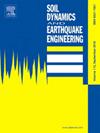Performance criterion and quantification of buried continuous steel pipelines subjected to reverse fault displacement
IF 4.2
2区 工程技术
Q1 ENGINEERING, GEOLOGICAL
引用次数: 0
Abstract
Local buckling of pipeline walls is a common failure mode for buried pipelines crossing reverse faults. The damage evolution of pipelines from initial buckling to severe failure under reverse fault displacement is closely related to soil properties, fault mechanism, and pipeline geometry. The performance-based design methodology proposed by the Pacific Earthquake Engineering Research Center has become well-recognized worldwide. However, current safety-based design codes for buried steel pipelines generally provide operable limits corresponding to the initiation of local buckling of the pipeline walls, and cannot be used to effectively assess the damage states and performance levels of pipelines. To address the local buckling of pipeline walls under fault displacement, a performance criterion is proposed based on the critical compressive strain and the change rate of pipeline compressive strain. Three performance levels corresponding to pipeline wall local buckling are identified, namely, buckling initiation, buckling development, and buckling failure. Moreover, the ductility coefficient that characterizes the nonlinear behavior of the pipeline wall prior to buckling failure is proposed in this study to quantify the damage state threshold values. Three-dimensional finite element models of the large-diameter pipeline crossing a reverse fault are developed and validated against the existing experiment study. Parametric analysis is performed to comprehensively assess the effects of pipeline burial depth, fault mechanism, and pipeline geometry on the performance of the buried steel pipeline under reverse fault displacement. Finally, the empirical equation for critical displacements between performance levels under different conditions is developed. The numerical results indicate that as the diameter-to-thickness ratio and burial depth of the pipeline increase, the structure ductility of the pipeline wall prior to buckling failure decreases. The structural ductility of the pipeline wall increases by 94.7 % as the fault dip angle increases from 30° to 90°. Moreover, the structural ductility increases when the internal pressure increases from 0 MPa to 6 MPa, but decreases as the internal pressure changes further from 6 MPa to 12 MPa.
求助全文
约1分钟内获得全文
求助全文
来源期刊

Soil Dynamics and Earthquake Engineering
工程技术-地球科学综合
CiteScore
7.50
自引率
15.00%
发文量
446
审稿时长
8 months
期刊介绍:
The journal aims to encourage and enhance the role of mechanics and other disciplines as they relate to earthquake engineering by providing opportunities for the publication of the work of applied mathematicians, engineers and other applied scientists involved in solving problems closely related to the field of earthquake engineering and geotechnical earthquake engineering.
Emphasis is placed on new concepts and techniques, but case histories will also be published if they enhance the presentation and understanding of new technical concepts.
 求助内容:
求助内容: 应助结果提醒方式:
应助结果提醒方式:


